BY LETTER
Hand-held Lasers
Technology > Technology Levels > High Tech / Hitech
Technology > Technology Levels > Middle Tech / Midtech
Technology > Application > Weapons > Personal Weapons
Technology > Application > Weapons > Surface Weapons
Technology > Technology Levels > Transapientech / Godtech / Clarketech
Technology > Technology Levels > Middle Tech / Midtech
Technology > Application > Weapons > Personal Weapons
Technology > Application > Weapons > Surface Weapons
Technology > Technology Levels > Transapientech / Godtech / Clarketech
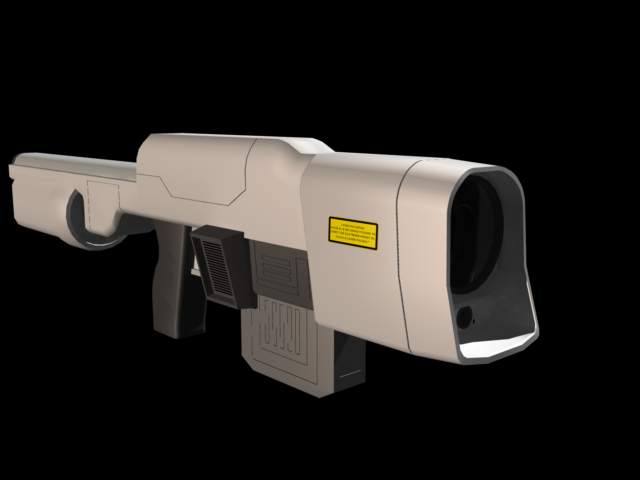 Image from Luke Campbell |
Handheld laser weapons have long been used in combat situations on planetary surfaces and elsewhere. The phase locked semiconductor Battle Laser depicted above, a typical Middletech example, emits infrared light at a wavelength of 1 micron with the option to frequency double to 0.5 micron green. A full power shot draws 10 kJ from the power pack and emits a 5 kJ beam delivered as a train of a great many ultrashort pulses lasting no more than a millisecond. This is sufficient to overpenetrate a human, leaving a hole about the width of that produced by a .30 caliber hunting bullet, and will punch through all but the heaviest armor that a person can wear. When used in an atmosphere, the beam is focused and chirped to begin filamentation shortly before reaching the target to overcome depth of field focusing limitations for close targets. Such filamentation does not occur when firing in vacuum.
The cooling system can dissipate the heat of up to two full power shots per second; with the cooling system off (or when firing very rapidly) up to 11 full power shots can be safely fired before there is any risk of overheating. The air intake for the cooling system fan can be seen in the stock of the weapon, and the exhaust vents near the butt of the stock.
The laser can emit lower powered beams for higher rates of sustained fire - a 1.6 kJ beam, for example, packs about as much punch as a 9 mm pistol bullet. It can also emit armor-piercing beams, with the energy and repetition rate of pulses that make up the beam optimized for drilling through hard materials rather than flesh. In addition, it can emit fan beams - two or more lower powered beams discharged at the same time, incident close enough to each other that their temporary blast cavities overlap and the tissue between them rips thus "cutting" a wider swath through the target.
With the pictured 6 cm aperture, the laser can focus on targets out to 500 meters distant to full effect (1 km if a green beam is used). Beyond that point, the blast effect of the beam is diminished by the reduced intensity. The primary lens can focus on targets as close as 1 meter. Any closer and the laser switches to a secondary close focus beam path - this is visible below the primary aperture in the pictures. The closest focal point of the secondary beam path is actually within the secondary beam tube, allowing engagement of targets at any distance from pressed against the front of the focal array out to hundreds of meters distant.
On either side of the secondary beam path are two additional beam channels for projecting a pair of filamented beams. A high voltage is applied across these beams, allowing the laser to be "set to stun," acting like a long range taser. If the voltage is applied at microwave frequencies, the ionized filamented beams act as a wave guide to deliver an electromagnetic pulse that shorts out electronics.
The pictured power pack is an ultracapacitor, with a mass of 1 kg and storing enough energy for 20 full powered shots and with enough power to allow 4 such shots per second. Both the rate of fire and total number of shots scale with power pack size, so a comparable weapon with a 0.5 kg power pack can fire 10 shots at 2 shots per second. Fast discharge batteries store considerably more energy per unit weight, but can discharge that energy much less rapidly. - heavy packs are required to handle a reasonable rate of fire, but this allows many more shots to be fired. Long duration batteries can store many times the number of shots, but the trickle of power they provide is not sufficient for powering a laser in combat without impractically large batteries - these can be used to recharge the ultracapacitors between firefights, however.
Lasers of this kind are fantastically accurate. Aiming is a simple matter of aligning the targeting reticule with the image of the target, and there is no need to correct for windage or bullet drop. Because the laser needs active focusing and adaptive optics to work, it is a small matter to also include beam stabilization that allows a rock-steady aim.
Laser beams are normally silent and when operating at Infrared frequencies are invisible without special optics (thermographic sensors will not see them, because it is the wrong frequency of infrared). There will be a visible white flash of star-hot plasma, flying sparks, and a loud bang from the explosion where the beam hits but no indication of where the beam came from. If the cooling fan is active, it will produce a quiet whir after the laser is fired. The beam will not penetrate water. If the laser switches to a green beam, a green line will be visible flashing through the air at the instant the laser is triggered, and a dazzling green flash where the beam hits. The visible green trace of the beam clearly gives away the firer's location. On the plus side, a green beam can keep a tight focus twice as far away and can shoot through a couple dozen meters of clear water. If the beam self focuses into light filaments, the filaments are visible as while light streaks that flash on for the briefest instant before fading.
Higher-tech handheld laser models use more advanced smart matter emitters, which are almost twice as efficient at producing light. Such emitters can double the beam output for the same energy input, while at the same time vastly reducing the cooling needs (you only need to shed as heat the energy that does not go into the beam). More advanced laser weapons also have a greater flexibility in beam color, which can be adjusted along a continuum from near infrared through the entire visible range and into the near ultraviolet. Room temperature superconductor or magmatter storage loops allow hi-tech handheld lasers to store much more power; a room temperature superconductor loop typically holds 15 to 20 MJ/kg - compare this to the 0.2 MJ/kg of the ultracapacitor in the medium-tech laser described above. A magmatter loop could hold such large amounts of energy that effectively unlimited shots are possible. Of course, not everyone can make or afford a magmatter power pack, and playing with magmatter has its own dangers.
Examples
Portable laser weapons from the Late Interplanetary Age. These were among the weapons used in the so-called 'Last War', at the time of the Great Expulsion. Copies of these weapons are still used today in historical re-enactments.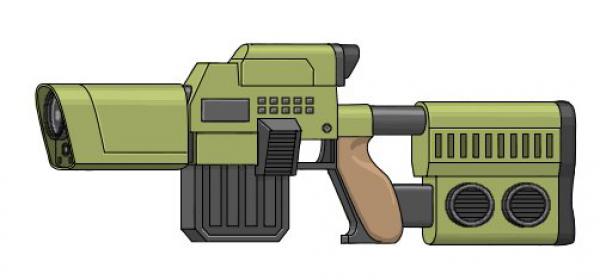 Image from Luke Campbell | |
| Assault Laser | |
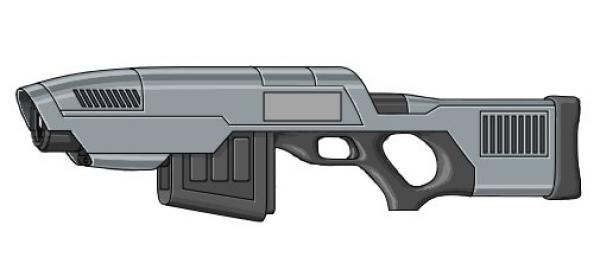 Image from Luke Campbell | |
| Battle Laser | |
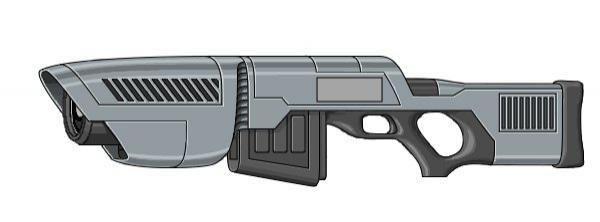 Image from Luke Campbell | |
| Sniper Laser: variant of the Battle Laser with larger aperture for accuracy at greater distance | |
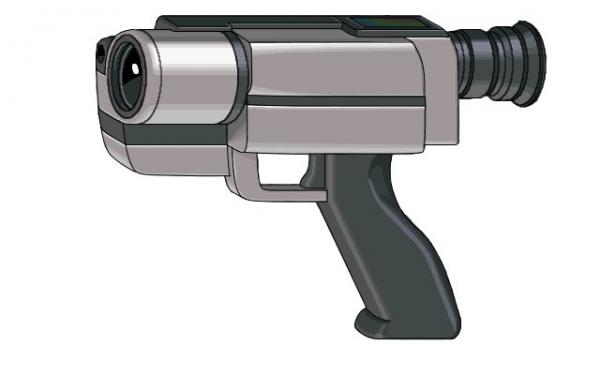 Image from Luke Campbell | |
| Heavy Laser Pistol | |
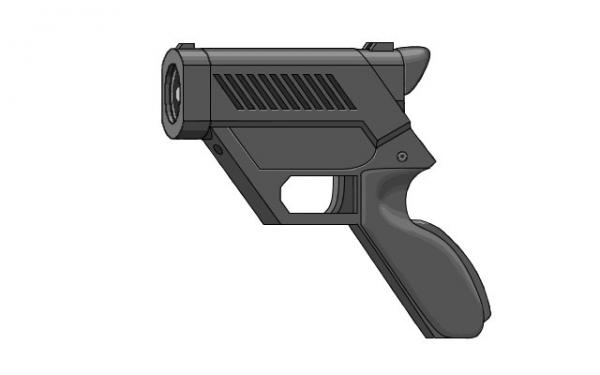 Image from Luke Campbell | |
| Light Laser Pistol | |
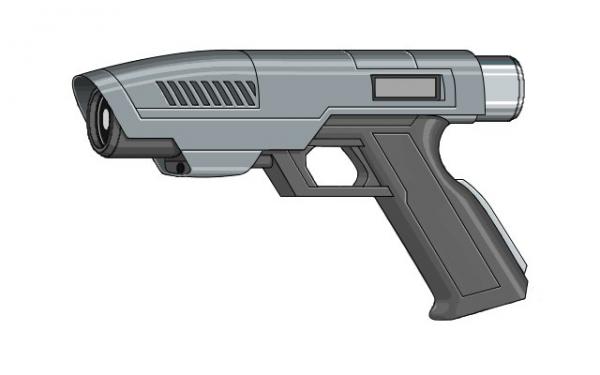 Image from Luke Campbell | |
| Medium Laser Pistol | |
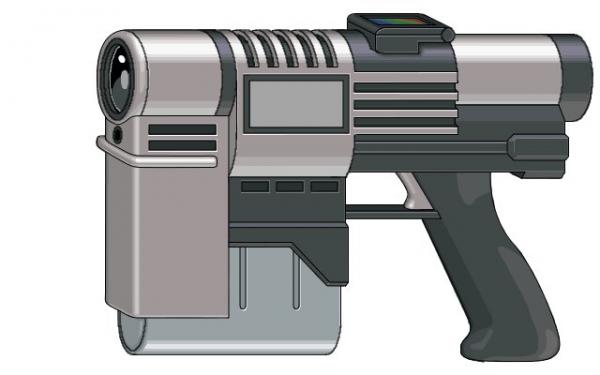 Image from Luke Campbell | |
| Auto Laser for rapid repeat fire | |
Related Articles
- Autocannon, Cannon
- Conversion Weapons
- Dusters
- Laser Weapons
- Melee/Close Combat Weapons
- Particle Beam Weapons
- Plasma Weapons
- Quadrail Gaussrifle
- Shoulder Laser
- Smart Weapons - Text by M. Alan Kazlev, from Anders Sandberg's Big Ideas Grand Vision
Weapons with have varying amounts of intelligence in them (rarely more than turingrade). The simplest Smart Weapons link to a control-command subturing and give the owner the ability to shift between types of ammo, see through the aimpoint camera etc. This kind of connection is necessary for use in teamware, and is practically standard among even the simplest baselines. The scramjet bullets of the sabot pistols of Trillicon have built in cameras and some limited steering capabilities. Zetatech's Marksman Gun is equipped with a n expert system that can act as a point defence or drone if placed on a tripod or suitable vehicle (although the price tag deters most people). - Squirt Guns
Appears in Topics
| High Tech / Hitech | Middle Tech / Midtech | Personal Weapons |
| Surface Weapons | Transapientech / Godtech / Clarketech |
Development Notes
Text by Luke Campbell
Initially published on 15 November 2007.
Initially published on 15 November 2007.






